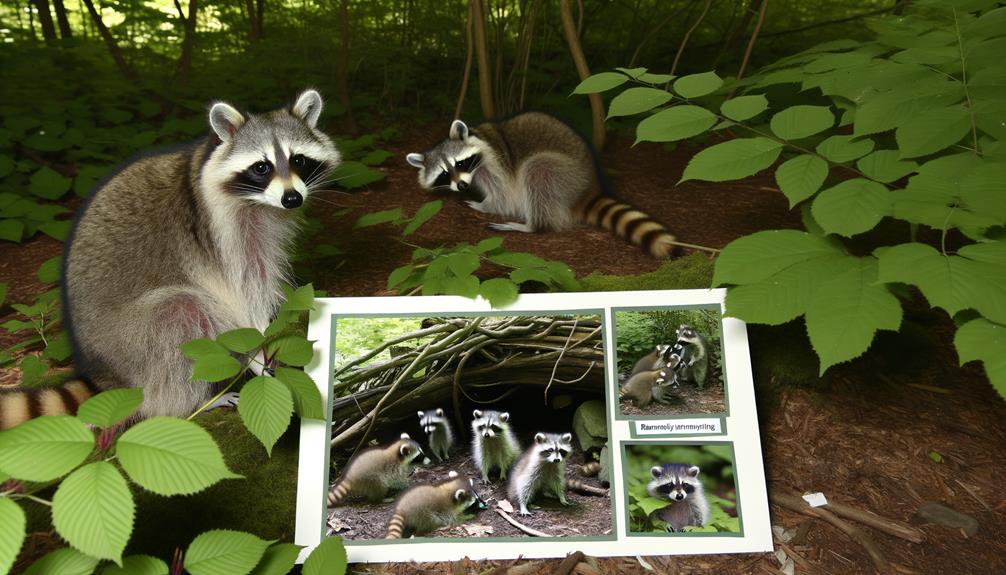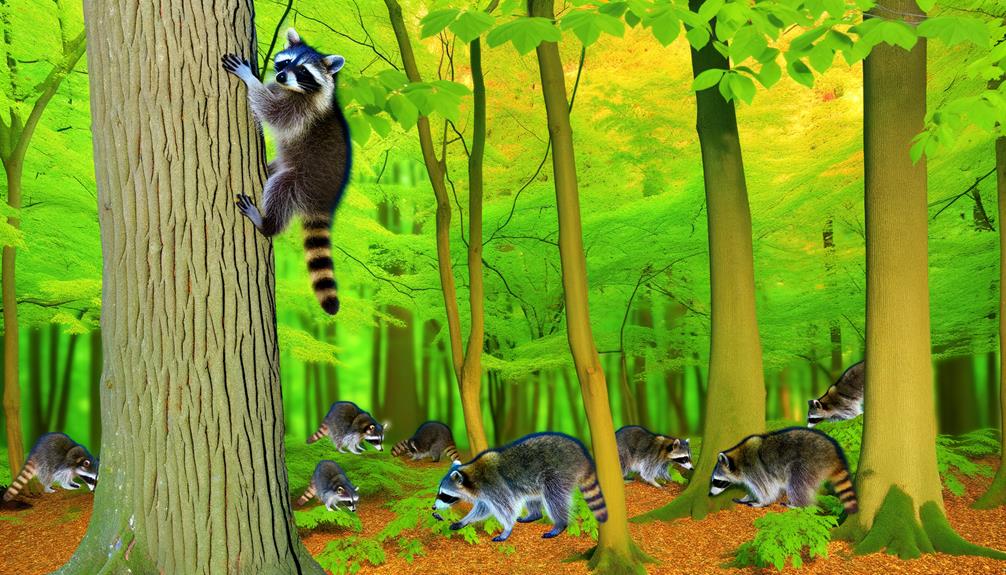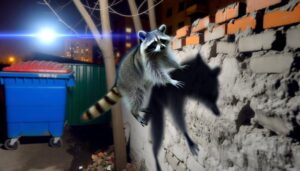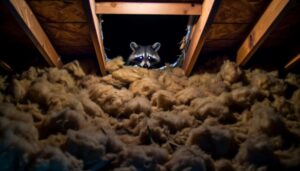How Fast Do Raccoons Grow?
Raccoons exhibit a rapid growth trajectory beginning from birth in early spring. Newborn kits weigh 60-75 grams and are blind, deaf, and immobile.
They open their eyes and develop auditory capabilities within 18-24 days. By 7-10 weeks, they shift to solid foods while continuing to gain independence and motor skills.
The juvenile phase sees significant physical and cognitive advancements as they explore and hone survival skills. Entering adolescence, their body mass doubles, and they refine complex social behaviors.
The foundation laid in these stages supports their evolution to independent adulthood. Discover more about the intricate stages of their development.

Key Takeaways
- Raccoon kits weigh 60-75 grams at birth and begin rapid growth immediately.
- Kits open their eyes between 18-24 days and start crawling shortly after.
- Kits begin eating solid food around 7-10 weeks, accelerating growth.
- During the juvenile phase, raccoons develop motor skills and problem-solving abilities.
- By adolescence, raccoons double their body mass and become more independent.
Birth and Early Life
Raccoon kits are typically born in early spring, following a gestation period of approximately 63 days. At birth, the kits are altricial, meaning they are born blind, deaf, and largely immobile, weighing between 60 to 75 grams. Their fur is sparse and lacks the distinct markings of adult raccoons.
The initial development phase is pivotal as the kits rely entirely on their mother for warmth, nutrition, and protection. Maternal care includes providing milk rich in essential nutrients necessary for rapid growth. The nesting environment, often a tree hollow or other sheltered area, offers a stable microclimate to support the sensitive early stages of life.
Understanding these initial conditions is essential to appreciating the subsequent growth and development of raccoons.
First Few Weeks
During the first few weeks of life, raccoon kits experience significant physiological and sensory development as they gradually open their eyes, begin to hear, and increase their mobility.
Typically, their eyes start to open between 18 and 24 days post-birth, marking the onset of visual perception. Auditory capabilities also emerge around this time, as their ear canals open.
Concurrently, kits start exhibiting greater motor skills, evidenced by their initial attempts to crawl and explore their immediate surroundings. This period is critical for neural development, characterized by rapid brain growth and sensory integration.
At this stage, their growth is primarily supported by the mother's milk, providing essential nutrients necessary for their robust development and increasing physical activity.
Weaning Period

As the weaning period commences, raccoon kits gradually shift from a diet solely consisting of maternal milk to incorporating solid foods. This shift typically begins around 7 to 10 weeks of age.
During this crucial phase, kits start to explore their environment more actively, foraging for insects, fruits, and small vertebrates under the supervision of the mother. The digestive system of the kits adapts to the new diet, enhancing their growth and development.
The mother continues to provide milk intermittently, ensuring the kits receive necessary nutrients. This balanced diet of milk and solids supports the rapid physical and cognitive development needed for eventual independence.
The weaning period is a pivotal step in the raccoon's early life cycle, laying the foundation for future survival skills.
Juvenile Phase
Following the weaning period, young raccoons enter the juvenile phase, marked by increased independence and continued growth in both physical and cognitive capacities. During this stage, which typically spans from 8 to 16 weeks of age, juvenile raccoons exhibit significant advancements in motor skills and problem-solving abilities. They start exploring their surroundings more extensively, honing their foraging techniques and social interactions.
Nutritional demands escalate, necessitating a varied diet to support rapid growth. Additionally, their fur becomes denser, and body mass increases noticeably. Behavioral observations indicate that play becomes more complex, aiding in the development of critical survival skills.
Adolescent Stage

The adolescent stage in raccoons, spanning from approximately 4 to 12 months of age, marks a period of continued growth and increasing autonomy from the mother. During this phase, raccoons exhibit significant physical and behavioral development. Their body mass approximately doubles, and they hone essential survival skills such as foraging and climbing.
Increased independence is observed as they gradually reduce their reliance on maternal care, participating in exploratory behavior and territorial establishment. Social interactions with siblings and other raccoons become more complex, playing an important role in learning social hierarchies and communication. Nonetheless, they still occasionally seek guidance and protection from the mother, especially when encountering unfamiliar threats.
This stage sets the foundation for their impending independent adult life.
Reaching Adulthood
Reaching adulthood, raccoons undergo further physiological maturation and behavioral refinement, culminating in the capability to independently navigate complex ecosystems.
By approximately 12 months of age, raccoons reach sexual maturity, evidenced by developed reproductive organs and readiness for mating.
Their foraging skills become more sophisticated, allowing them to exploit a variety of food sources efficiently.
Adult raccoons exhibit heightened spatial awareness and advanced problem-solving abilities, essential for survival in diverse habitats.
Additionally, social behaviors evolve, with increased solitary tendencies except during mating season.
Their physical development includes enhanced muscle strength and agility, vital for climbing and swimming.
Consequently, raccoons emerge as adaptable, resourceful creatures, fully prepared to sustain themselves and perpetuate their species in challenging environments.
Conclusion
In summation, raccoons exhibit a rapid and remarkable growth trajectory from birth to adulthood. Initially blind and helpless, they develop critical survival skills and physical capabilities at an astonishing pace.
The shift from the weaning period to the juvenile phase marks a significant milestone, characterized by increased independence and exploratory behaviors.
By the adolescent stage, raccoons are nearly fully developed, ready to face the complexities of their ecosystem.
Truly, their growth is nothing short of miraculous, reflecting intricate biological and ecological processes.






